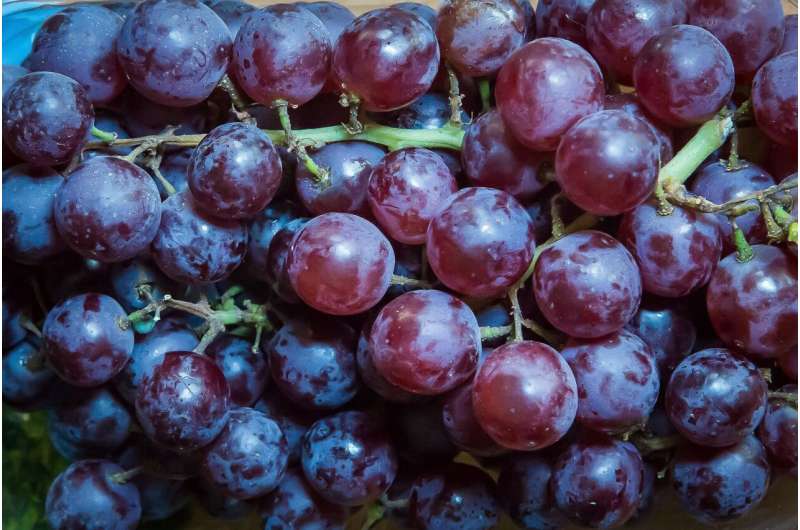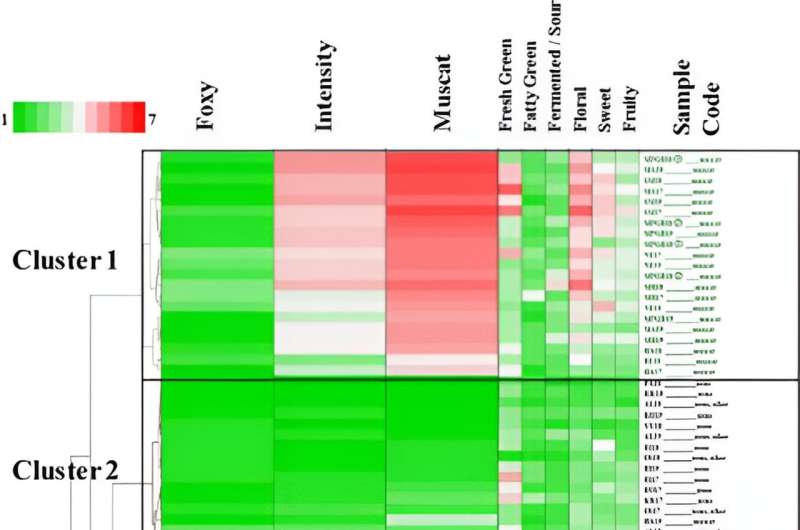This article has been reviewed according to Science X's editorial process and policies. Editors have highlighted the following attributes while ensuring the content's credibility:
fact-checked
peer-reviewed publication
proofread
Study reveals diverse flavor profiles in 38 grape cultivars

The flavor of table grapes, influenced by various volatile compounds, plays a significant role in consumer preference and marketability. Traditional flavor analysis methods often fail to capture the complexity and diversity of grape flavors, especially in hybrid varieties.
Conventional flavor classifications like muscat and foxy are insufficient for describing the wide range of flavors in modern grape cultivars. Due to these challenges, there is a need for in-depth research to comprehensively analyze and categorize the diverse flavor profiles of table grapes, aiding in the development of superior grape varieties with enhanced flavor qualities.
Researchers from the University of Tsukuba and the National Agriculture and Food Research Organization (NARO) in Japan have made significant strides in this area. Their findings, published in Horticulture Research on February 26, 2024, reveal a comprehensive analysis of the volatile compounds in table grapes, shedding light on the factors that influence their flavor.
The study analyzed the flavors and volatile compounds of 38 grape cultivars using sensory evaluation and solvent-assisted flavor evaporation (SAFE), a technique that effectively recovers trace and high-boiling-point compounds at low temperatures. Researchers characterized the cultivars and grouped them into seven clusters based on sensory data, highlighting the flavor diversity of table grapes.
The SAFE method provided comprehensive profiles of volatile compounds, including α-pinene, β-pinene, phenylethyl alcohol, furaneol, mesifurane, methyl N-formylanthranilate, and mixed ethyl ester and monoterpenoid, which contribute to flavors such as fresh green, floral, fruity, fatty green, sweet, and fermented/sour. The study identified novel flavor-associated compound profiles in table grapes through multivariate analysis, revealing specific accumulations and combinations of compounds that enhance flavor intensity and diversity.

This research offers a deeper understanding of the chemical basis of grape flavors, potentially guiding breeding and cultivation practices to improve the flavor quality of table grapes.
Dr. Sumiko Sugaya, the corresponding author, stated, "This study provides valuable insights into the complex flavor profiles of table grapes. By identifying the specific volatile compounds responsible for different flavors, we can better understand how to cultivate and breed grape varieties with enhanced flavor qualities. This research not only benefits grape producers but also helps consumers enjoy a richer and more diverse flavor experience."
The implications of this research are far-reaching, offering a roadmap for breeders to develop new grape cultivars with tailored flavors. Additionally, these findings could revolutionize the wine and food industries by providing a scientific basis for enhancing the flavor profiles of their products.
More information: Kazuki Moriyama et al, Diversity of flavour characteristics of table grapes and their contributing volatile compounds analysed by the solvent-assisted flavour evaporation method, Horticulture Research (2024). DOI: 10.1093/hr/uhae048
Journal information: Horticulture Research
Provided by TranSpread


















